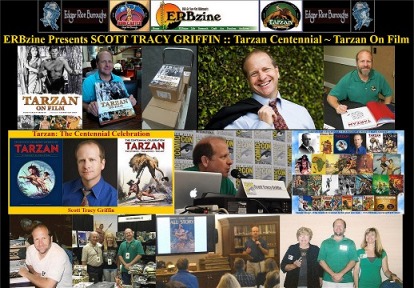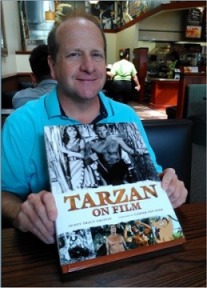Celebrating the Tarzan Film Centennial #125
 .
.
Rod La Rocque ::
Murray Kinnell
On August 2, 1933, Metro-Goldwyn-Mayer
began principal photography on “Tarzan and His Mate, the sequel to the
1932 hit, “Tarzan the Ape Man.” Johnny Weissmuller and Maureen O’Sullivan
reprised their roles as Tarzan and his mate, Jane Parker, with Neil Hamilton
returning as Harry Holt, a romantic rival who hoped to lure Jane into returning
to civilization with him after looting the priceless ivory in the elephants’
graveyard.
The cast also included Rod La Rocque as Holt’s lascivious
partner Martin Arlington, who has his own designs on Jane, and Murray Kinnell
(as Tom Pierce) and Frank Reicher (as Henry Van Ness), two rivals in the
race to the ivory wonderland.
After 3½ weeks of filming, production shut down
the first unit, reconvening in early September with silent screen idol
La Rocque replaced by Paul Cavanagh, and Kinnell and Reicher replaced by
William Stack and Desmond Roberts, respectively. The trade paper “Hollywood
Reporter” attributed the shutdown to “miscasting”.
Silent screen idol Rod La Rocque was initially
cast in the role of the lascivious Martin Arlington, who has designs on
Jane (Maureen O’Sullivan) in MGM’s “Tarzan and His Mate” (1934), but was
replaced by actor Paul Cavanagh after 3½ weeks of filming, with
now reason given. The trade paper “Hollywood Reporter” attributed it to
“miscasting.”
Roderick Ross LaRocque was born November 29, 1898 in
Chicago, Illinois. He began appearing in stock productions in his teens,
followed by vaudeville, then film roles after producer Samuel Goldwyn discovered
him on the Broadway stage. The role of Dan McTavish in Cecil B. DeMille’s
“The Ten Commandments” (1923) launched his career as a silent era matinee
idol. In 1927, La Rocque married silent film leading lady Vilma Banky,
with DeMille serving as his best man. After retiring from film, La Rocque
worked in real estate. He died at home in Beverly Hills on October 15,
1969, survived by Banky, his wife of 42 years
Murray Kinnell was originally cast in the
role of Tom Pierce, one of a pair of ivory hunters racing Harry Holt (Neil
Hamilton) and Martin Arlington (originally Rod La Rocque, replaced with
Paul Cavanagh) to the elephants' graveyard, in “Tarzan and His Mate” (1934).
After 3½ weeks of filming, the production shut down; when production
resumed, Kinnell had been replaced with William Stack, with no reason given
for the change. The trade paper “Hollywood Reporter” attributed it to “miscasting.”
Born July 24, 1889 in London, Kinnell appeared in more
than 70 films. His best-known role was “Putty Nose” in “The Public Enemy”
(1931), starring James Cagney. Kinnell passed away on August 11 1954 in
Santa Barbara, California, survived by his wife Henrietta, and is buried
at the Santa Barbara Cemetery.
Frank Reicher almost followed his role
as Captain Englehorn in "King Kong" (1933) and “The Son of Kong” (1933)
with another role in an iconic adventure film, "Tarzan and His Mate" (1934),
but after 3½ weeks of shooting, the production shut down and Reicher
was replaced in the role of Henry Van Ness by actor Desmond Roberts, as
one of a pair of ivory hunters racing Harry Holt (Neil Hamilton) and Martin
Arlington (originally Rod La Rocque, replaced with Paul Cavanagh) to the
elephants' graveyard.
Reicher was born to a stage family in Munich, Germany
on December 2, 1875. After studying drama, he emigrated to New York in
1899 to appear on Broadway, eventually transitioning into a film actor
in Hollywood and appearing, usually as a supporting character, in more
than 200 films. Reicher also worked as a producer, director, and drama
teacher. He died January 19, 1965, survived by a sister and brother, and
is interred at Inglewood Park Cemetery.

Frank Reicher (Captain Englehorn), Bruce Cabot (John Driscoll),
Fay Wray (Ann Darrow)
and Robert Armstrong (Carl Denham) in a scene from RKO's "King Kong"
(1933).


 .
. 


![]()
![]()
![]()
![]()
![]()
![]()
![]()
![]()
